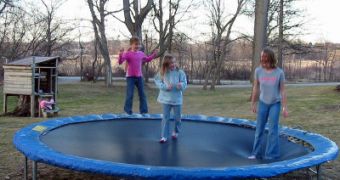A while ago, when Heidi Klum put in an appearance on Jimmy Kimmel and brought a trampoline on stage to demonstrate how much fun it was to jump around a large, bouncy piece of fabric stretched over a steel frame, it all looked extremely fun and appealing. So much so, in fact, that trampoline sales have soared in recent months, and with the coming of summer, they have become must-have garden accessories, particularly for families with children. At first sight, they look ideal: they help children exercise and they're great fun - however, doctors warn that the number of trampoline injuries in young children has also increased - with very serious consequences.
Using a trampoline may be fun, but experts have shown that it is also extremely risky. Only in the UK, trampoline accidents have increased by 50% over the past six years, and there has been a dramatic rise in very serious injuries - such as broken necks, spinal cord injuries, and disabling head traumas - among young children. Even more alarmingly, many of these injuries result in permanent paralysis and even death. Trampolines have also been proved to be responsible for a very large number of less serious but still extremely painful injuries, such as broken bones, muscle damage and various types of dislocations.
As far as trampoline injuries go, children are the most exposed group. Safety regulations regarding trampoline use state that only one person should be allowed on a trampoline in one go, and that they're not suitable for children under six. However, few people know or follow these rules. Doctors warn that children aged six or under do not have the coordination or spatial awareness to deal with an activity as complex as trampolining, which is why they often suffer serious injuries. "Most of the injuries occurred on the trampoline, rather than from falling off. The most common were ankle and neck sprains, followed by upper limb fractures," orthopedic surgeon Richard Sinnerton explained to the Daily Mail.

 14 DAY TRIAL //
14 DAY TRIAL //